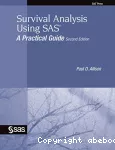 Accueil
Accueil
| Titre : | Survival analysis using the SAS® : a practical guide |
| Auteurs : | D. Allison Paul |
| Type de document : | texte imprimé |
| Mention d'édition : | 2nd ed. |
| Editeur : | Cary (N.C.) : SAS Publishing, 2010 |
| ISBN/ISSN/EAN : | 978-1-59994-640-5 |
| Format : | 324 p. |
| Langues: | Anglais |
| Catégories : |
Thésaurus CEREQ ANALYSE DES DONNEES ; INFORMATIQUE ; METHODOLOGIE ; MANUEL INFORMATIQUE |
| Résumé : |
Easy to read and comprehensive, Survival Analysis Using SAS: A Practical Guide, Second Edition, by Paul D. Allison, is an accessible, data-based introduction to methods of survival analysis. Researchers who want to analyze survival data with SAS will find just what they need with this fully updated new edition that incorporates the many enhancements in SAS procedures for survival analysis in SAS 9. Although the book assumes only a minimal knowledge of SAS, more experienced users will learn new techniques of data input and manipulation. Numerous examples of SAS code and output make this an eminently practical book, ensuring that even the uninitiated become sophisticated users of survival analysis. The main topics presented include censoring, survival curves, Kaplan-Meier estimation, accelerated failure time models, Cox regression models, and discrete-time analysis. Also included are topics not usually covered in survival analysis books, such as time-dependent covariates, competing risks, and repeated events.
Survival Analysis Using SAS: A Practical Guide, Second Edition, has been thoroughly updated for SAS 9, and all figures are presented using ODS graphics. This new edition also documents major enhancements to the STRATA statement in the LIFETEST procedure; includes a section on the PROBPLOT command, which offers graphical methods to evaluate the fit of each parametric regression model; introduces the new BAYES statement for both parametric and Cox models, which allows the user to do a Bayesian analysis using MCMC methods; demonstrates the use of the counting process syntax as an alternative method for handling time-dependent covariates; contains a section on cumulative incidence functions; and describes the use of the new GLIMMIX procedure to estimate random-effects models for discrete-time data. (4ème de couv.) |
| Document Céreq : | Non |
Exemplaires (1)
| Code-barres | Cote | Support | Localisation | Section | Disponibilité |
|---|---|---|---|---|---|
| 1035888 | O-151-15 | Ouvrage | CEREQ | Bibliothèque | Disponible |





